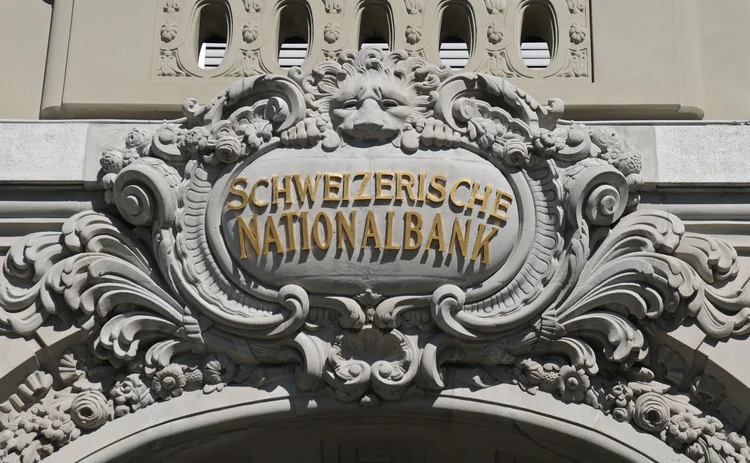
Reserve manager of the year: Swiss National Bank
New trading capabilities have helped to better manage liquidity as assets hit $825 billion

The Swiss National Bank has already cemented its role as a world reference in reserve management during the past 15 years. It has led the way by harnessing risk management skills to secure higher returns and preserve capital, as it added traditionally riskier assets to its portfolio. The process coincided with a sharp increase of reserves, as the SNB has carried out foreign exchange interventions to prevent an overvaluation of the Swiss franc against the euro. But the institution has not rested on its laurels. In the past 18 months or so, the Swiss central bank completed the wholesale reorganisation of its asset management unit, which is now split into trading and analysis, in a bid to increase trading efficiency and analytical capabilities. The transformation was underpinned by the in-house development and implementation of a technology platform designed to ease the interactions between both teams.

The restructuring of asset management was made in response to challenges imposed by changing market conditions and the growing size of the central bank’s reserves. “Before 2018, we had one specialist for each market doing everything: analysis, making decisions about which positions to take and implementing the trading,” says Sandro Streit, head of asset management at the SNB. “Now, we have a separation between portfolio trading and portfolio management.”
One of the main reasons behind this change was the increasing need to carry out large transactions due to increasing assets under management connected with the SNB’s monetary policy. “At the same time, we witnessed a fall in liquidity in markets such as corporate bonds. This meant we needed more and more time to conduct the actual trading,” he adds.
In 2016, the asset management unit decided to set up a new trading desk. Now, 50% of its staff are traders and 50% are doing analysis and decision-making. Including the SNB’s Singapore office, which manages Asian assets, the unit now counts 12–13 staff members in each department. However, the new trading desk is not merely an execution unit, with the portfolio manager telling the trader to buy a certain bond at any specific price, the manager instead indicates the kind of position she would like to achieve in risk exposure terms.
“For instance, you might want to be invested in one company with a specific risk budget, then the trader decides what the best way to implement that view is. Is it safe to buy a derivative or is it better to buy a bond – and if so, which bond? The trader makes all these decisions,” says Streit.
In-house technology solution
To ensure the new approach worked properly, the SNB first needed to establish a technology system allowing rapid interaction between portfolio managers and traders. The unit needed a platform providing both the risk positions that portfolio managers enter, and an assessment of whether traders implemented these guidelines without deviating from the strategic asset allocation. For that reason, the SNB did not believe it could not use an existing system.
“In this environment, we want to measure our portfolio managers and our traders. It is not as simple as just measuring the performance of the portfolio against a benchmark, as in the past,” says Streit. “Measuring portfolio management is not very complex because we track all the targets each of the portfolio managers sets.”
They enter their targets into the platform, and every night this information is automatically uploaded to a virtual portfolio, what the unit calls the analyst benchmark. This is compared against the official benchmark to measure the value added by the portfolio manager.
We have increased our capabilities to do good portfolio analysis, but also the ability to do good portfolio trading
Sandro Streit, SNB
“On the trading side, measuring the performance is more difficult because trading generally creates costs. So how do you measure the trade has been done at the lowest possible cost?” says Streit. “We use reference prices. On the equity side, it is easy to see what kind of prices were paid at an exchange. But on the fixed income side, you need to rely on some reference prices. And most of these references are for smaller tickets than what we usually do.”
The unit addressed this problem by differentiating individual operations carried out by traders. In order to evaluate trading, it takes reference prices and compares how good the trader was in relation to the average trading on that day. “I think we now have a good database, which is well documented. We have increased our capabilities to do good portfolio analysis, but also the ability to do good portfolio trading,” he adds.
A pioneer risk manager
The foreign currency investments the SNB has acquired in a bid to limit the Swiss franc’s appreciation against the euro, and maintain inflation closer to target, entail hefty exchange and volatility risks. Since November 2010, this portfolio has multiplied from Sfr213.7 billion ($219.7 billion) to Sfr804.6 billion in November 2019. In this period, asset allocation has experienced important changes. Government bonds have fallen from 83% of the portfolio to 68%, while other bonds including corporate bonds have risen from 6% to 12%, and equities from 10% to 20%.
“The Swiss National Bank has certainly been one of the leading central banks in adjusting its risk profile in accordance with the increase the size of the reserves,” says Andrew Abir, deputy governor at the Bank of Israel and former director of market operations. “And it has been at the forefront of central banks, which have gone from managing a very conservative investment portfolio to including riskier assets, as this has become befitting to improve the risk-return profile of investments.”
The risk management unit comprises 15 full-time members, and it is also divided into two teams. One is the risk control team, which focuses on risk analysis, setting limits, risk concepts and performance measurement. The other is the investment policy team, which is involved in the creation of the investment framework, long-term asset allocation, investment universe and establishing strategic benchmarks.

“We conducted numerous analyses, and concluded that, measuring risk in Swiss francs, with an asset allocation of 20% into stocks the whole portfolio is less risky than, for instance, a pure government bond portfolio, and the return expectation is higher,” says Erich Gmür, director of the risk management unit at the SNB. “With this strategy, we contribute to having a more robust balance sheet.”
In spite of these operational divisions, the asset and risk management units work closely together. They are involved in the same processes, but deal in the creation and implementation of the central bank’s investment policy at different stages.
Exchange rate and volatility risk
The SNB faces substantial currency risks because almost all its reserve holdings are in foreign currency. However, as part of its core monetary policy is to manage the exchange rate, the central bank cannot hedge its forex reserves against exchange rate risk – this would essentially undo the monetary policy effect intended by its forex interventions.
This in part explains why the SNB’s fixed income portfolio has a longer duration than many other central banks. Its duration was 4.6 years in the third quarter of 2019, up from 3.9 years in the third quarter of 2010. The long duration in effect hedges some of the SNB’s currency risks. Since the Swiss franc is a ‘safe-haven’ currency, it would be expected to appreciate during a major crisis. At the same time, this appreciation in the franc would make the SNB’s reserves, reported in francs, less valuable. But the central bank would make significant capital gains on its bond portfolios if interest rates were lowered in a bid to combat a major crisis.
The diversification carried out by the SNB – not just in asset classes, but also geographically – is extraordinary. And this has not only been the case in the fixed income portfolio, but also in equities and currencies
Gerardo García, Bank of Mexico
The longer duration in the fixed income portfolio also helps to tackle volatility risks from a possible decline in the value of equities during a downturn.

“In our own experience, having riskier assets has gone hand in hand with lengthening the duration of the fixed income part of the portfolio because of the negative correlation between risky assets such as equities and high-quality fixed income in times of crisis,” says Abir from the Bank of Israel, which diversified into equities in 2012.
“The diversification carried out by the SNB – not just in asset classes, but also geographically – is extraordinary. And this has not only been the case in the fixed income portfolio, but also in equities and currencies,” says Gerardo García, director of international operations at the Bank of Mexico. The SNB has added currencies to reduce concentration risk. It has included the South Korean won, Australian and Singaporean dollars, the Swedish and Danish currencies, and Chinese renminbi.
The Swiss central bank monitors potential new currencies, but not many meet its requirements. “We are looking for deep capital markets where you can actually invest in,” says Gmür. “We would also need a currency that is lowly correlated with the existing currencies we have and with a reasonable credit quality.”
While some markets may look attractive, the central bank may not move into them because they are simply too small and could hamper the SNB’s market neutrality goal.
“If we were in less liquid markets, our ability to reduce our share without distorting them would take a long time,” says Gmür. “We want to have an investable market where we can put significant amounts of funds without becoming an important player.”
This also maintains adequate levels of liquidity. As an asset manager, the SNB is governed by the primacy of monetary policy, and the investment policy must ensure that the balance sheet can be used for monetary policy purposes at any time. In particular, the SNB must be in a position to expand or shrink the balance sheet if necessary.
The Central Banking Awards were written by Christopher Jeffery, Daniel Hinge, Dan Hardie, Rachael King, Victor Mendez-Barreira, Alice Shen and William Towning
Only users who have a paid subscription or are part of a corporate subscription are able to print or copy content.
To access these options, along with all other subscription benefits, please contact info@centralbanking.com or view our subscription options here: subscriptions.centralbanking.com/subscribe
You are currently unable to print this content. Please contact info@centralbanking.com to find out more.
You are currently unable to copy this content. Please contact info@centralbanking.com to find out more.
Copyright Infopro Digital Limited. All rights reserved.
As outlined in our terms and conditions, https://www.infopro-digital.com/terms-and-conditions/subscriptions/ (point 2.4), printing is limited to a single copy.
If you would like to purchase additional rights please email info@centralbanking.com test test test
Copyright Infopro Digital Limited. All rights reserved.
You may share this content using our article tools. As outlined in our terms and conditions, https://www.infopro-digital.com/terms-and-conditions/subscriptions/ (clause 2.4), an Authorised User may only make one copy of the materials for their own personal use. You must also comply with the restrictions in clause 2.5.
If you would like to purchase additional rights please email info@centralbanking.com test test test




